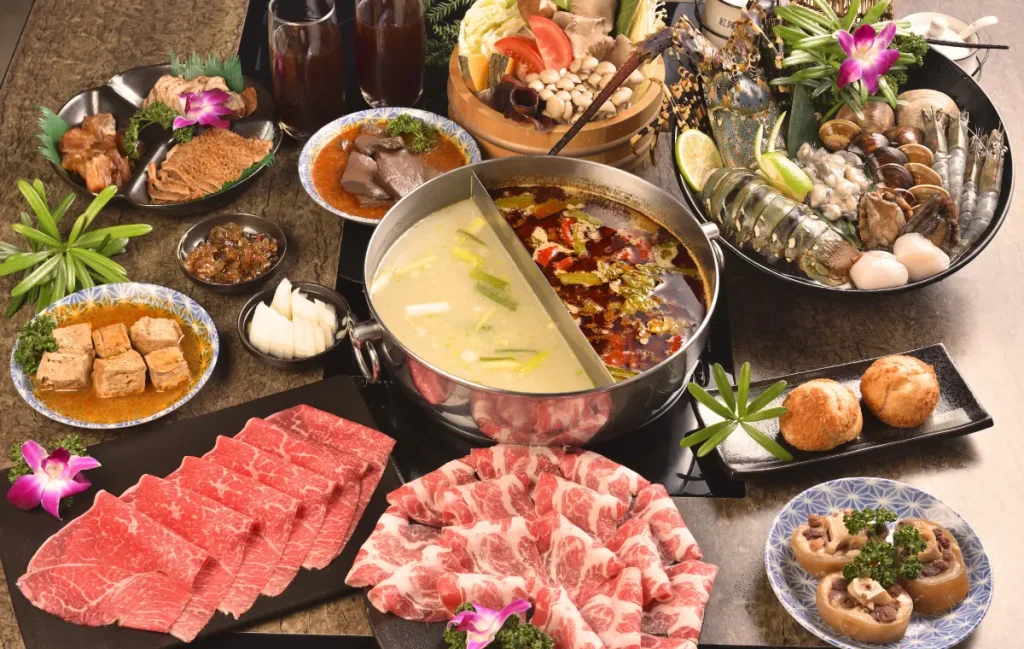If you’re like me and grew up glued to classic TVB dramas, you’ll remember how characters from the network’s golden era always seemed to unwind after work around a bubbling pot of 打边炉 (dǎ biān lú) — the Cantonese term for what most other regions simply call hotpot (火锅, huǒguō).
Whether it was a circle of friends swapping gossip or colleagues bonding over wafer-thin beef and fragrant dipping sauces, those scenes made hotpot look like the ultimate comfort food and social ritual. And honestly, they weren’t wrong.
Have you ever gathered around a steaming pot with friends or family, cooking delicious morsels to perfection right at your table? If not, get ready — because today we’re diving deep into the wonderful world of Chinese hotpot. It’s more than just a meal; it’s a communal experience, a celebration of bold flavors, and a fantastic way to connect with loved ones.
And trust me, once you try it, you’ll be hooked!
What Is Chinese Hotpot?
So, what is Chinese hotpot?
Imagine a simmering pot of flavorful broth placed right in the center of your dining table.
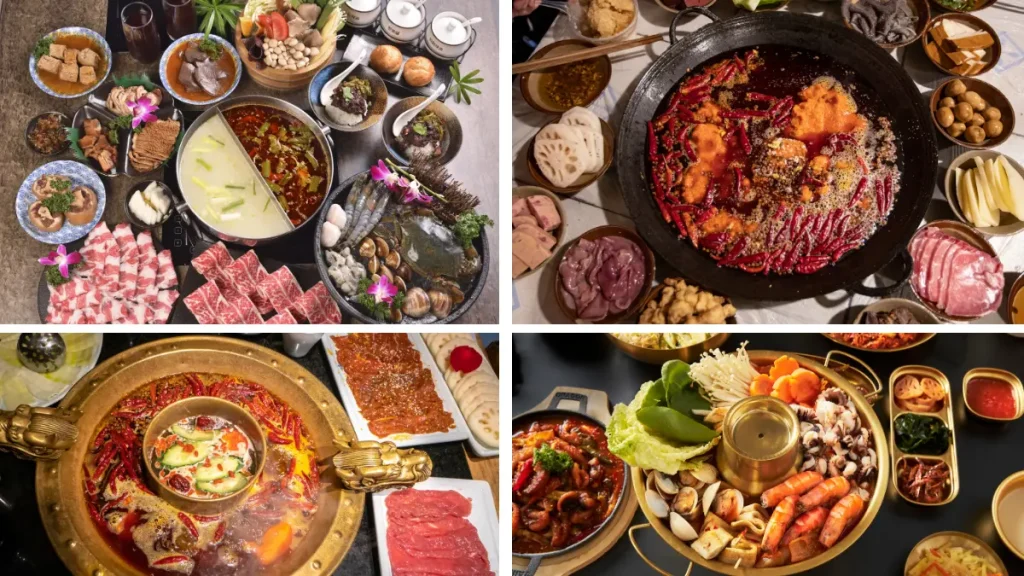
Around it, you’ll find an array of fresh, thinly sliced meats, vibrant vegetables, delicate noodles, and various other delicious ingredients.
The magic happens as everyone dips their chosen items into the bubbling broth, cooking them to their liking, and then enjoying them with a personalized dipping sauce.
It’s interactive, it’s customizable, and it’s incredibly fun!
At its heart, hotpot is a communal cooking method that has been cherished in China for centuries. It’s known as huǒguō (火锅) in Mandarin, which literally translates to “fire pot” — a fitting name for this warm and inviting culinary tradition.
If you’re wondering what is hotpot in Chinese, now you know! And speaking of Chinese, if you’re curious about Chinese culture or eager to learn the language, you’re already in the right place at StellarChinese.com! Bookmark this page and share it on your favourite social media platform to spread the love for Chinese language and culture!
A Glimpse into Traditional Chinese Hotpot
While the concept of cooking food in a communal pot exists in many cultures, traditional Chinese hotpot has its own unique charm and history.
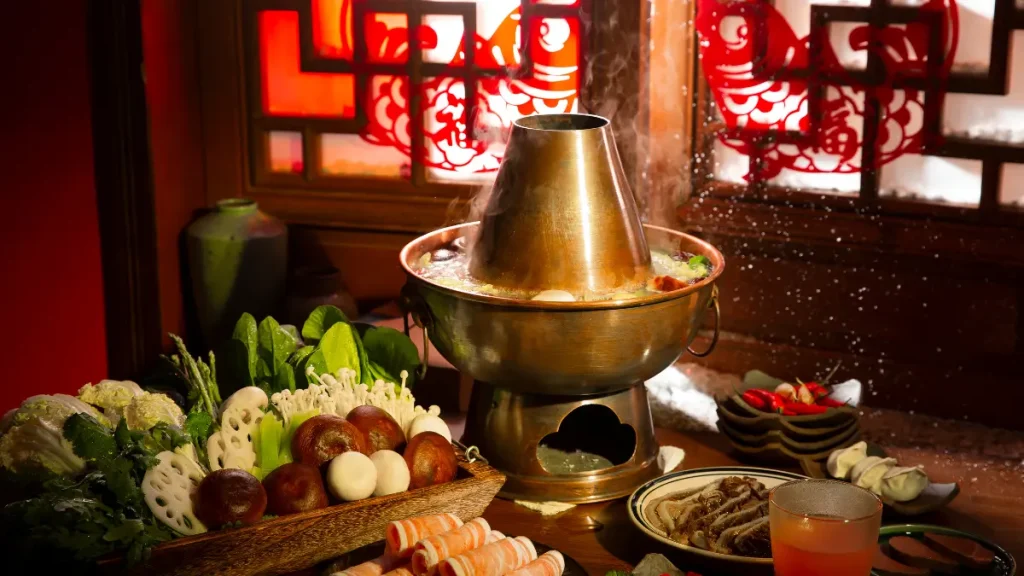
Hotpot has been around in China for over 2,000 years. The idea of cooking food in a shared pot goes way back to ancient times, even before the Mongols.
Later on, during the Yuan Dynasty, the Mongols helped popularise a northern-style hotpot that used thinly sliced mutton cooked in a copper pot, which is still common in Beijing today.
Over the centuries, hotpot spread across China and turned into all kinds of regional styles.
Some are super spicy and numbing like Sichuan hotpot, while others are mild and comforting, like the mutton broth in the north or the fresh seafood hotpot from southern China. No matter your taste, there’s a hotpot style out there for you.
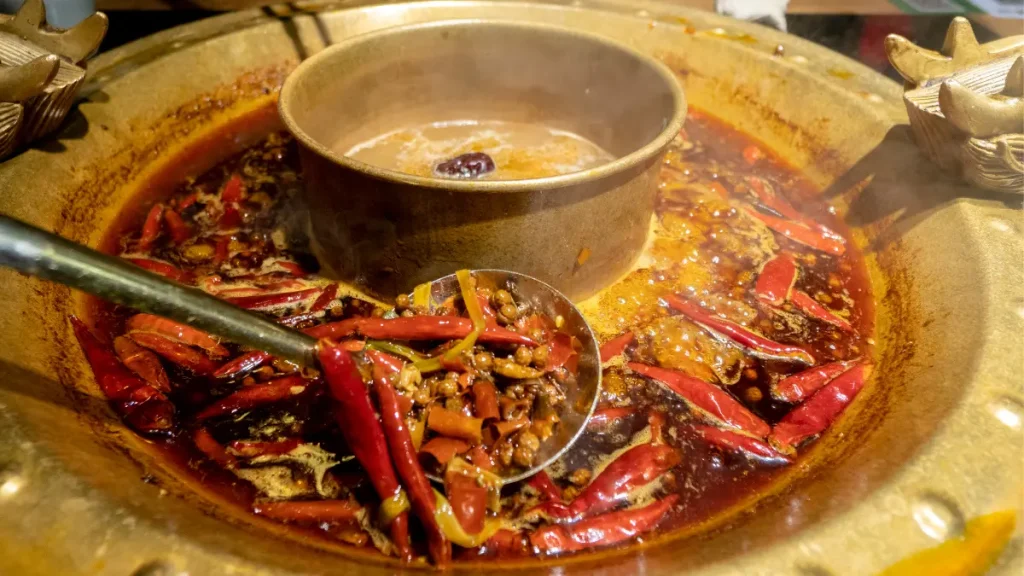
Side note: When I don’t know what to eat, hotpot is my go-to. There’s just something about sitting around a bubbling pot with friends that instantly lifts your mood — especially in winter. The steam rising from the broth, the sound of food gently cooking, and the fun of picking out perfectly cooked bites one by one… it’s cosy, comforting, and somehow makes everything taste better. On a cold night, there’s honestly nothing more satisfying.
And it doesn’t always have to be a group thing — sometimes, it’s just as rewarding to enjoy hotpot alone at home, curled up with your furry friend on a rainy day, binge-watching your favourite show or movie. Total comfort.
What to Avoid at Hotpot: Tips for a Smooth Experience
While hotpot is all about enjoyment, there are a few things to keep in mind to ensure a smooth and safe experience. Knowing what to avoid at hotpot can make all the difference, especially if you’re new to this culinary adventure.
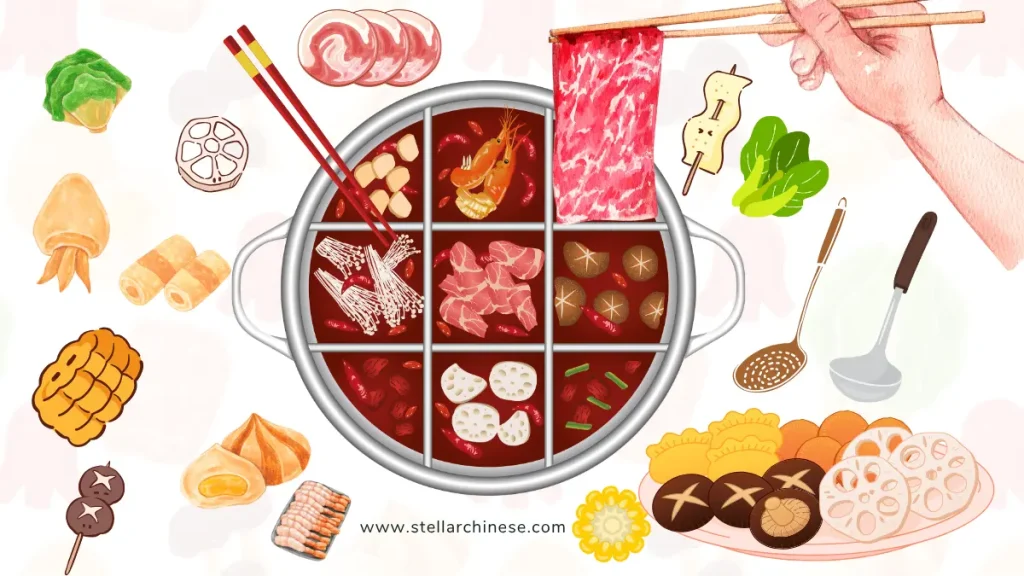
First and foremost, hygiene is key. If you’re sharing a communal pot, it’s good practice to use separate chopsticks or utensils to place raw ingredients into the broth and to retrieve cooked food. This helps prevent cross-contamination, especially with raw meats. Some hotpot enthusiasts even recommend having a dedicated pair of long-handled chopsticks or a ladle and skimmer set (you can find great options like these on Amazon!) specifically for the hotpot itself, reserving your personal chopsticks for eating. I personally picked up a set of Reusable Chinese Dragon and Phoenix Chopsticks from Amazon — stylish, traditional, and perfect for this kind of meal. Not only do they look beautiful, but they also come in a box with holders, which keeps everything neat and easy to bring along for gatherings.
Another thing to be mindful of is overfilling the pot. While it might be tempting to throw everything in at once, this can lower the broth temperature and make it harder to cook ingredients evenly. Cook in small batches, allowing the broth to return to a simmer between additions. This also ensures that each piece of food is cooked thoroughly, which is particularly important for meats and seafood.
You also want to be cautious with processed foods. While popular, items like fish balls and some processed meat products can be high in sodium and unhealthy fats. While they can be enjoyed in moderation, focusing on fresh, whole ingredients like lean meats, plenty of vegetables, and wholesome noodles will make your hotpot experience healthier and more satisfying.
This also ties into the question of are Chinese hot pots healthy?
And the answer is — it really depends! Since ingredients are poached in broth rather than fried, it’s generally lower in fat than many other Chinese dishes. The healthiness of hotpot largely comes down to your ingredient choices, broth (汤底 tāng dǐ), and dipping sauces (酱料 jiàng liào).
Also read: 199+ Essential Words to Spice Up Your Vocabulary
If you’re loading up on fresh veggies, lean proteins like seafood or tofu, and using a clear or herbal broth, hotpot can be incredibly nourishing.
On the flip side, if you go heavy on processed meats, fatty cuts, and super oily spicy broths, it can quickly lean the other way. Even sauces play a role — some are light and full of garlic and herbs, while others are rich in oil, sugar, or sesame paste.
Hotpot is as healthy (or indulgent) as you make it. That’s part of the beauty — it’s totally customisable.
How to Make Chinese Hotpot at Home
Ready to bring the hotpot experience into your own home?
It’s easier than you think!
Learning how to make Chinese hotpot is all about setting up your station and gathering your favorite ingredients. Think of it as your culinary canvas, where you get to choose every color and stroke.
Essential Hotpot Equipment
To get started, you’ll need a few key pieces of equipment. The good news is, most of these are readily available on Amazon, making it super convenient to set up your own hotpot haven!
- Electric Hotpot Cookers: These are a game-changer for home hotpot. Quality electric hotpot cookers can keep your broth simmering perfectly at the table. Many come with adjustable temperature controls and non-stick surfaces for easy cleanup. Some even have a grill plate, allowing you to enjoy a hotpot and BBQ combo!
- Tabletop Gas Burners or Induction Cooktops: If you prefer a more traditional setup or already have a favorite pot, a portable butane gas stove or an induction cooktop is a fantastic alternative. These provide consistent heat and are easy to store. Just remember to have extra butane canisters on hand if you go the gas route!
- Divided Hotpot Pots (Yin-Yang Style): Want to offer two different broth flavors at once? A yin-yang style divided hotpot pot is a must-have! This allows you to have a spicy broth on one side and a milder, savory broth on the other, catering to everyone’s preferences. Many of these are designed to work with induction cooktops or directly on electric burners.
- Hotpot Starter Kits: For ultimate convenience, consider a hotpot starter kit. These often include a pot, burner, and sometimes even basic utensils, making it a perfect gift for a hotpot newbie or a great way to jumpstart your own collection.
- Ladle and Skimmer Sets: These are indispensable for retrieving your cooked ingredients from the hotpot. Look for stainless steel sets with long handles and small mesh skimmers to easily scoop out delicate items without losing them in the broth. I like to use this E-far silicone utensil set because it comes with a ladle and skimmer — both with stainless steel handles and heat-resistant silicone heads. The long handles are great for safety, and the skimmer is perfect for fishing out dumplings or tofu without losing them in the broth. Plus, it’s a full 7-piece set, so you can use the extras for everyday cooking too.
Crafting Your Chinese Hotpot Broth
The heart of any hotpot is its broth. This is where the magic begins, infusing all your ingredients with incredible flavor. You can make your own from scratch, or for an easy Chinese hotpot recipe, you can use pre-made concentrates. These are perfect for busy weeknights or when you want to experiment with different flavors without the fuss.
- Chinese Hotpot Base / Chinese Hotpot Soup Base: For a quick and delicious broth, consider using broth base concentrates from popular brands like Little Sheep or Haidilao. These are widely available on Amazon and come in a variety of flavors, from rich and savory mushroom to fiery Sichuan mala. They take the guesswork out of seasoning and provide an authentic taste with minimal effort. Simply dilute with water or your favorite stock, and you’re ready to go!
- Chinese Hotpot Broth (from scratch): If you’re feeling adventurous, making your own broth allows for complete customization. A simple yet flavorful base can be made by simmering chicken or pork bones with aromatics like ginger, green onions, and dried goji berries. For a vegetarian option, a mushroom-based broth with dried shiitake and kombu is incredibly rich and satisfying.
Essential Chinese Hotpot Ingredients
Now for the fun part — choosing your ingredients! The beauty of hotpot is that there are endless possibilities. Here’s a breakdown of common Chinese hotpot ingredients:

- Meats: Thinly sliced meats are a hotpot staple — think ribeye, short rib, lamb, pork belly, or chicken. The thin cuts cook quickly and soak up the broth’s flavour beautifully. You can often find pre-sliced hotpot meats at your local Asian grocery store.
- Seafood: Shrimp, fish fillets (tilapia, cod), scallops, and squid rings are popular choices. Ensure they are fresh and cut into bite-sized pieces.
- Tofu & Tofu Products: A variety of tofu adds wonderful texture and absorbs flavor. Options include firm tofu, fried tofu puffs, frozen tofu, and tofu skin.
- Chinese Hotpot Noodles: Noodles are a must-have for soaking up all that delicious broth. Popular choices include glass noodles (mung bean vermicelli), fresh wide potato noodles, udon, or instant ramen noodles.
- Chinese Hotpot Vegetables: Load up on fresh vegetables! They add sweetness and nutrients to your hotpot. Some favorites include:
– Napa cabbage
– Bok choy
– Spinach
– Enoki mushrooms
– Shiitake mushrooms
– King oyster mushrooms
– Corn on the cob (cut into rounds)
– Lotus root (thinly sliced)
– Potatoes (thinly sliced)
– Winter melon
Other Delights: Don’t forget items like fish balls, meatballs, quail eggs, and dumplings. These add variety and are always a hit.
The Art of the Dipping Sauce
No hotpot experience is complete without a personalized dipping sauce! This is where you truly make the meal your own. Learning to create your perfect Chinese hotpot dipping sauce is an art form.
Most hotpot restaurants offer a sauce bar with a dizzying array of condiments, but you can easily replicate this at home with a few key ingredients.
- Chinese Hotpot Sauce Essentials:
– Sesame Paste: A rich, nutty base for many sauces.
– Chili Oil: For that signature spicy kick. Brands like Lao Gan Ma are highly recommended.
– Fermented Tofu (Furu): Adds a unique savory, umami depth. A small amount goes a long way! Personally, I’m not a big fan, but many people absolutely love its bold flavour.
– Soy Sauce: Light or dark, depending on your preference.
– Vinegar: Black vinegar or rice vinegar for a tangy note.
– Garlic: Fresh minced garlic is a must.
– Cilantro: Freshly chopped for a burst of freshness.
– Scallions: Green onions, finely chopped.
– Oyster Sauce: For a touch of sweetness and umami.
– Sacha Sauce (Chinese BBQ Sauce): A savory, slightly spicy, and umami-rich paste.
DIY Dipping Sauce Kits: You can even put together your own dipping sauce kits for extra convenience. For a truly organised setup, use sectional condiment trays or ceramic sauce bowls like this one to keep everything tidy and within reach.
How to Eat Chinese Hotpot: A Step-by-Step Guide
Now that you have all your ingredients and equipment ready, let’s talk about how to eat Chinese hotpot like a pro! It’s a relaxed and social affair, but a few pointers can enhance your experience:
1. Set the Scene: Arrange your hotpot cooker in the center of the table. Surround it with all your prepared ingredients, neatly arranged on platters. Have individual bowls for broth and smaller bowls for dipping sauces, along with chopsticks and ladles.
2. Broth First: Pour your chosen hotpot broth into the pot and bring it to a rolling boil.
3. Sauce Station: Each diner creates their own dipping sauce. Encourage everyone to experiment with different combinations of sesame paste, chili oil, soy sauce, garlic, cilantro, and other condiments.
4. Cook and Enjoy: Once the broth is boiling, start adding ingredients. Begin with items that take longer to cook, like root vegetables or denser meats. Thinly sliced meats and leafy greens cook very quickly — often just a few seconds! Use your hotpot ladle or dedicated chopsticks to submerge your chosen items in the broth until cooked through. Retrieve them, dip them in your personalized sauce, and enjoy!
5. Top Up and Rotate: Keep an eye on the broth level — it can reduce as you cook, so don’t forget to add hot water when needed. As you eat, continue adding more ingredients to the pot to keep it bubbling and full. This way, there’s always something cooking and ready to enjoy!
6. Sip the Broth (optional): As the meal progresses, the broth becomes richer and more flavorful from all the cooked ingredients. Don’t forget to ladle some into your bowl and savor it — it’s a delicious part of the experience! I don’t usually drink the broth, but many hotpot fans swear by it!
Chinese Hotpot Near Me: Finding a Restaurant
While making hotpot at home is a fantastic experience, sometimes you just want to head out and soak in the buzz of a proper Chinese hotpot restaurant. To find one nearby, a quick Google Maps or Yelp search for “Chinese hotpot near me” usually brings up plenty of options. Look for highly rated spots with reviews that mention fresh ingredients, a wide variety of broths, and a good range of dipping sauces.
Pro tip: One trick I use? I take a quick glance around — if there are lots of Chinese customers happily eating there, that’s usually a good sign.
Many cities, especially those with a large Asian community, have a variety of hotpot restaurants — from low-key, casual joints to more upscale venues. You might even come across a popular Chinese hotpot chain like Haidilao, famous not just for its food, but also for its next-level service and fun extras like noodle dancing right at your table.
Here are some fun videos from Haidilao for your reference:
Whether it’s the famous noodle dance, robot servers, or their viral “Kēmù Sān” dance, these clips give you a taste of the unique experience that makes Haidilao more than just a meal — it’s a full-on performance.
FAQs
Is hotpot Chinese?
Yes, hotpot is deeply rooted in Chinese culinary tradition, with origins that trace back over 1,000 years — and possibly as far as 2,000 years. While similar communal cooking styles exist in other cultures, Chinese hotpot stands out for its rich regional variations, distinctive ingredients, and deep cultural significance.
Are Chinese hotpots healthy?
Chinese hotpot can absolutely be a healthy meal! Since the ingredients are cooked by gently poaching in broth, it typically involves much less oil and fat than stir-frying or deep-frying. That said, the healthiness really comes down to your choices — opt for lean meats, plenty of vegetables, and minimal processed items. The broth (soup base) and dipping sauces also make a difference. Clear or herbal broths are lighter, while rich, spicy bases can be heavier. Similarly, sauces with lots of oil, sugar, or salt can add up quickly. With mindful choices, hotpot can be both satisfying and nutritious.
What do you usually put in a hotpot?
You can put a wide variety of ingredients in a hotpot! Common items include thinly sliced meats (beef, lamb, pork), seafood (shrimp, fish fillets), various types of tofu, a wide array of fresh vegetables (napa cabbage, bok choy, mushrooms), and different kinds of noodles. The beauty is in customizing it to your taste!
Is hotpot junk food?
No, hotpot is generally not considered junk food. In fact, it can be a very nutritious and balanced meal. While some processed ingredients or heavy dipping sauces can add calories and unhealthy fats, the core concept of cooking fresh ingredients in a simmering broth is inherently healthy. It offers a great way to consume a diverse range of vegetables and lean proteins.
Final Thoughts
Chinese hotpot is more than just a meal; it’s an experience that nourishes both body and soul. It’s about sharing, connecting, and savoring delicious food with those you care about.
Whether you choose to explore the vibrant hotpot scene at a Chinese hotpot restaurant or create your own cozy hotpot haven at home with an easy Chinese hotpot recipe, you’re in for a treat.
So, gather your ingredients, fire up your pot, and get ready to dip into a world of flavor. Your hotpot adventure awaits! And remember, for all your authentic Chinese culinary needs and insights, keep coming back to StellarChinese.com!
